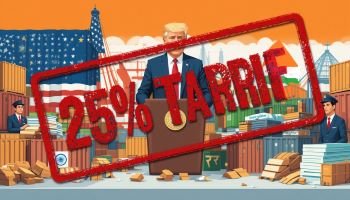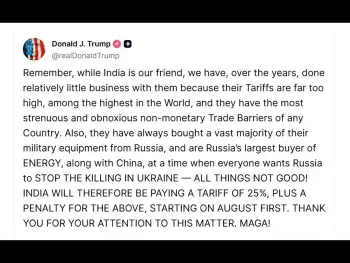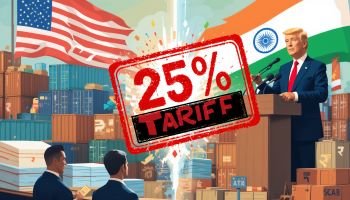Turbulence Ahead: How President Trump Tariff Impact Is Shaking Indian Markets
August 1, 2025– President Trump tariff impact on Indian markets has triggered one of the most dramatic escalations in U.S.-India trade tensions in recent memory. President Trump, now in his second term, announced sweeping 25% tariffs on a broad range of Indian exports, accusing India of “unfair practices and persistent trade imbalances.” The decision sent immediate shockwaves through Indian stock markets and currency exchanges, marking the most significant U.S. trade offensive against India in nearly a decade. Exporters are now scrambling to contain the fallout, while policymakers in New Delhi reassess their next move in an increasingly unpredictable global trade landscape.
🎯 What’s Targeted, and What’s Spared
The new tariff covers approximately $40 billion worth of Indian goods, including key exports like textiles, leather, automotive parts, gems & jewellery, and chemicals. Notably, critical sectors such as pharmaceuticals, refined petroleum, semiconductors, and IT hardware have been left untouched, for now.
According to official data, these affected exports represent around 13% of India’s total shipments to the U.S, its single-largest trading partner.
Within hours of the announcement, Indian exporters began receiving revised orders, renegotiated contracts, and in some cases, outright cancellations. The fallout from President Trump tariff impact on Indian markets is already visible.
📉 Rupee Weakens, Markets Wobble
The financial repercussions were swift. The Indian rupee plunged to ₹87.6 per dollar, its lowest in nearly two years, as foreign investors dumped over ₹16,000 crore (~$2 billion) worth of Indian equities in July alone. Benchmark indices tumbled, with the Nifty 50 closing down over 400 points on tariff fears.
Economists are now adjusting India’s GDP projections for FY 2025–26 downward, forecasting a 0.3–0.4% drop in growth, primarily due to weakened export momentum and global uncertainty. They have also predicted that Indian will definitely face President Trump tariff impact in almost every sectors.

🔍 Sector-by-Sector Breakdown
Here’s how major industries are feeling President Trump tariff impact on Indian markets:
- 📦 Textiles & Apparel : With over 60% of their exports heading to the U.S., Indian textile firms like Arvind, Welspun, and Gokaldas are facing immediate cost pressures. Exporters from Tamil Nadu and Gujarat warn of potential job cuts and delayed expansion plans.
- 💎 Gems & Jewellery : The diamond and gold export hubs of Surat and Mumbai are seeing abrupt order declines. With higher landed costs in the U.S., Indian Jewellery is fast losing price competitiveness to Chinese and Vietnamese counterparts.
- 🏭 Auto Components : Component manufacturers in Pune and Chennai are reassessing their U.S. supply deals. While this sector is partially insulated, suppliers in casting, electricals, and steering systems are most vulnerable.
- 💊 Pharmaceuticals : One of the few bright spots. Exempted from tariffs, pharma giants like Sun Pharma and Dr. Reddy’s remain stable—for now. However, industry insiders remain cautious, wary of future regulatory or trade-related surprises.
- 🧴 Specialty Chemicals & Leather : Exporters in Gujarat and West Bengal report immediate setbacks. Some leather exporters have already begun exploring rerouting products to Europe and the Gulf to offset U.S. losses.
🏛️ Delhi’s Tightrope Walk
India has thus far refrained from retaliatory tariffs, instead emphasizing dialogue. Commerce ministry officials have confirmed that backchannel talks with the U.S. Trade Representative are underway, focused on tariff rollbacks and improved market access for American dairy and tech companies.
But New Delhi has made it clear—strategic sectors like agriculture, data localization, and GM foods are non-negotiable. That makes finding a compromise more complicated.
“India wants fair trade, not one-sided trade deals,” a senior official told the media this week. The government is also in talks with ASEAN and EU nations to diversify export dependencies, a long-overdue strategy now accelerated by President Trump tariff impact on Indian markets.
📈 Investor Playbook: What to Watch
- Currency Intervention: Expect RBI to step in to stabilize the rupee. Bond yields and forex reserves will be key signals to watch.
- Export Stocks: Analysts recommend trimming exposure to export-heavy mid-caps, especially in textile, auto, and gems.
- Domestic Demand Sectors: FMCG, retail, and infrastructure sectors may become safe havens for investors.
- Bilateral Progress: Any sign of a breakthrough in Indo-U.S. trade dialogue could trigger short-term relief rallies.
🔄 Long-Term Impact: A Fork in the Road
While this tariff shock is undoubtedly painful, it may also be a necessary jolt. India’s dependence on the U.S. market has long been flagged by trade experts. President Trump tariff impact on Indian markets could force companies to diversify their destinations and improve manufacturing efficiency.
At the same time, this move threatens to erode India’s position as a reliable alternative to China in the global supply chain. Smaller exporters, especially MSMEs, may find it difficult to stay afloat without government support.
✍️ Conclusion: No Easy Answers
This isn’t just a policy decision—it’s a geopolitical power play with real-world economic consequences. As the global trade order undergoes another Trump-era recalibration, India must adapt quickly and strategically.
One thing is clear: President Trump tariff impact on Indian markets has opened a new chapter in Indo-U.S. trade dynamics—one defined by confrontation, complexity, and high-stakes diplomacy.
Also Read : Artificial Intelligence and Machine Learning: Everything You Need to Know in 2025
🧾 FAQs: President Trump Tariff Impact on Indian Markets
1. What is President Trump tariff, and when did it take effect?
Answer:
On August 1, 2025, U.S. President Donald Trump announced a 25% tariff on a wide range of Indian exports. This policy applies to nearly $40 billion worth of goods, including textiles, automotive components, gems, chemicals, and leather. The tariff is part of a broader push by the U.S. to correct what Trump described as “unfair trade practices and persistent imbalances.” This marks the most aggressive U.S. trade action against India in over a decade.
2. Why did President Trump impose a 25% tariff specifically on Indian exports?
Answer:
According to official statements, the tariffs were imposed due to alleged unfair trade practices, subsidies, and a rising U.S. trade deficit with India. The Trump administration argues that India benefits disproportionately from access to the U.S. market while restricting American businesses through tariffs and regulatory barriers, especially in agriculture and technology.
3. Which Indian industries are most affected by the 25% tariff?
Answer:
Industries that heavily rely on exports to the U.S. are the most vulnerable. These include:
- Textiles & garments
- Gems & Jewellery
- Automotive components
- Leather goods
- Specialty chemicals
Export hubs like Gujarat, West Bengal, and Tamil Nadu are seeing immediate disruptions in orders and revenue, with MSMEs particularly hard-hit.
4. Are any Indian exports exempt from President Trump tariff impact?
Answer:
Yes. Pharmaceuticals, semiconductors, refined petroleum, and critical IT hardware have been exempted from the tariff. These sectors are considered strategically important for both countries and were likely spared to avoid disrupting essential supply chains or sparking further diplomatic backlash.

5. How is the Indian stock market reacting to the new tariff policy?
Answer:
The announcement triggered a sharp sell-off on Indian stock exchanges. The Nifty 50 and Sensex both dropped significantly in the days following the announcement. Export-driven stocks, particularly in textiles, auto components, and chemicals, saw steep declines. Investors are adopting a more cautious stance, shifting towards domestically focused sectors like FMCG and infrastructure.
6. How will President Trump tariff impact on the Indian rupee?
Answer:
The rupee fell to ₹87.6 per U.S. dollar, marking its lowest level since 2023. The combination of investor anxiety, foreign portfolio outflows, and uncertainty about future U.S.-India trade relations has weakened the currency. The Reserve Bank of India is expected to intervene to stabilize the exchange rate.
7. Will this tariff reduce India’s GDP growth in 2025–26?
Answer:
Economists estimate a GDP slowdown of 0.3% to 0.4% for FY 2025–26 due to the impact on exports, manufacturing, and investor sentiment. While domestic demand remains strong, the drop in outbound shipments and declining foreign investment could dent overall economic momentum if the tariffs persist.
8. Is the Indian government planning to retaliate or negotiate President Trump tariff impact?
Answer:
India has chosen not to retaliate immediately, signaling that it prefers diplomatic resolution over escalation. High-level talks are underway, with Indian officials exploring possible concessions in areas like tech imports, market access, and trade compliance. However, India has ruled out opening sensitive sectors like dairy, agriculture, and GM foods to U.S. firms.
9. What are Indian exporters doing to manage the crisis?
Answer:
To navigate the challenges posed by the President Trump tariff impact, Indian exporters are implementing a range of survival strategies:
Re-routing shipments to other markets (EU, ASEAN, Middle East)
Lobbying for government relief such as interest subsidies and tax benefits
Renegotiating contracts and delivery timelines with U.S. buyers
Exploring local markets to offset declining exports
Despite these efforts, many MSMEs may still face job losses and financial distress if the tariffs are not lifted soon.
10. What’s the long-term outlook for India–U.S. trade relations?
Answer:
While the current phase is turbulent, many analysts believe the tensions are negotiable and temporary. The U.S. still sees India as a critical ally in the Indo-Pacific region, and India remains a preferred alternative to China in global supply chains. The long-term outlook depends on upcoming trade talks, domestic policy reforms, and geopolitical alignment in sectors like defense, tech, and energy.
Stay connected with Premiere News for Latest Indian and World News related to top political developments, business insights, tech innovations, health trends, or entertainment buzz – we’ve got it covered with accuracy and provide complete details. So stay connected with us through Premiere News website, Facebook, Instagram and Twitter accounts.




